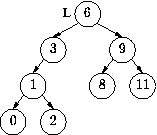

There is another simple situation: suppose the node we're deleting has only one subtree. In the following example, `3' has only 1 subtree.
To delete a node with 1 subtree, we just `link past' the node, i.e. connect the parent of the node directly to the node's only subtree. This always works, whether the one subtree is on the left or on the right. Deleting `3' gives us:
which we normally draw:
Finally, let us consider the only remaining case: how to delete a node having two subtrees. For example, how to delete `6'? We'd like to do this with minimum amount of work and disruption to the structure of the tree.
The standard solution is based on this idea: we leave the node containing `6' exactly where it is, but we get rid of the value 6 and find another value to store in the `6' node. This value is taken from a node below the `6's node, and it is that node that is actually removed from the tree.
So, here is the plan. Starting with:
Erase 6, but keep its node:
Now, what value can we move into the vacated node and have a binary search tree? Well, here's how to figure it out. If we choose value X, then:
Here it is:
So our general algorithm is: to delete N, if it has two subtrees, replace the value in N with the largest value in its left subtree and then delete the node with the largest value from its left subtree.
Note: The largest value in the left subtree will never have two subtrees. Why? Because if it's the largest value it cannot have a right subtree.Finally, there is nothing special about the left subtree. We could do the same thing with the right subtree: just use the smallest value in the right subtree.